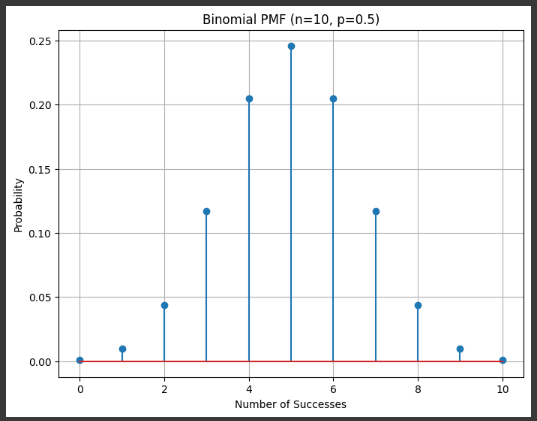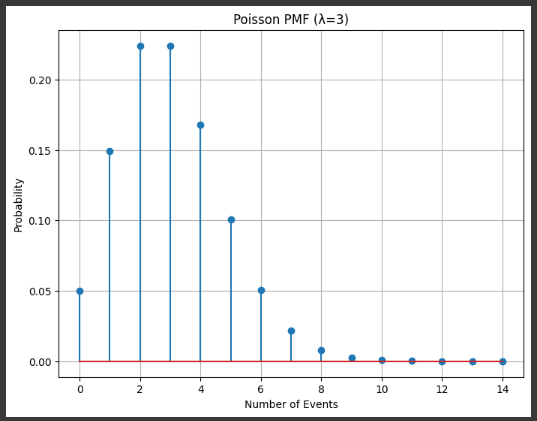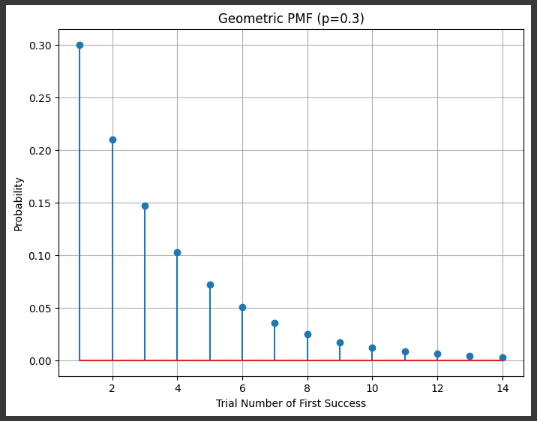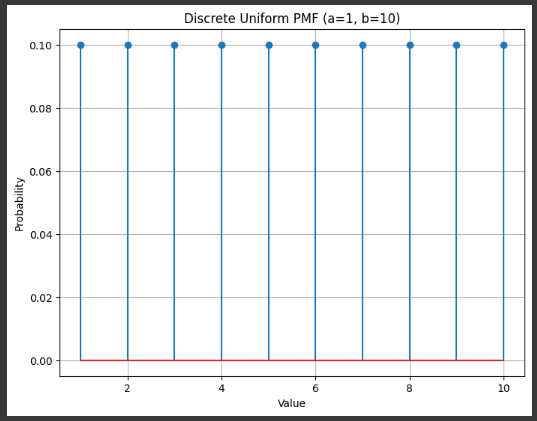Python probability mass function
import numpy as np
import matplotlib.pyplot as plt
from scipy.stats import binom, poisson, geom, randint
Example 1 Binom
success or failure, multiple trials each time
n = 10 # number of trials
p = 0.5 # probability of success
k = np.arange(0, n+1)
pmf = binom.pmf(k, n, p)
plt.figure(figsize=(8, 6))
plt.stem(k, pmf)
plt.title(f'Binomial PMF (n={n}, p={p})')
plt.xlabel('Number of Successes')
plt.ylabel('Probability')
plt.grid(True)
plt.show()

Example 2 Poisson
number of events happening in a fixed interval of time
lambda_poisson = 3 # average rate
k = np.arange(0, 15)
pmf = poisson.pmf(k, lambda_poisson)
plt.figure(figsize=(8, 6))
plt.stem(k, pmf)
plt.title(f'Poisson PMF (λ={lambda_poisson})')
plt.xlabel('Number of Events')
plt.ylabel('Probability')
plt.grid(True)
plt.show()

Example 3 Geometric
trials till first success
p_geom = 0.3 # probability of success
k = np.arange(1, 15)
pmf = geom.pmf(k, p_geom)
plt.figure(figsize=(8, 6))
plt.stem(k, pmf)
plt.title(f'Geometric PMF (p={p_geom})')
plt.xlabel('Trial Number of First Success')
plt.ylabel('Probability')
plt.grid(True)
plt.show()

Example 4 Uniform
equal likelyhood of result
# Parameters
a_uniform = 1 # lower bound
b_uniform = 10 # upper bound
# Range of possible values
k = np.arange(a_uniform, b_uniform + 1)
# PMF values
pmf = randint.pmf(k, a_uniform, b_uniform + 1)
# Plotting
plt.figure(figsize=(8, 6))
plt.stem(k, pmf)
plt.title(f'Discrete Uniform PMF (a={a_uniform}, b={b_uniform})')
plt.xlabel('Value')
plt.ylabel('Probability')
plt.grid(True)
plt.show()

Ryan is a Data Scientist at a fintech company, where he focuses on fraud prevention in underwriting and risk. Before that, he worked as a Data Analyst at a tax software company. He holds a degree in Electrical Engineering from UCF.
